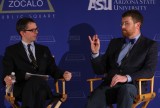
Name the following piece of music: Da-da-da-DUM. If you guessed Beethoven’s Fifth Symphony, you were right—and not alone. The Fifth may be the most famous piece of music ever written, and it has thrilled audiences for over 200 years. But why? We’ve argued for centuries over what distinguishes the sublime from the average. We’re mystified by the workings of genius, no matter how many records it leaves. (Think of Einstein’s Zurich notebooks or Beethoven’s countless letters and musical jottings.) We struggle to cultivate the imagination or “creativity,” yet we have little sense of how to do it and few indications we’ve made any progress in our understanding since the days of Aristotle. Boston Globe music critic Matthew Guerrieri, author of The First Four Notes: Beethoven’s Fifth and the Human Imagination, a book about the history, legacy, and interpretations of Beethoven’s most famous work, visits Zócalo to discuss the mysteries of genius and the human imagination.
2301 North Central Avenue
Phoenix, AZ 85004
The Takeaway
Name That Tune: Da-Da-Da-DUM
Matthew Guerrieri On Beethoven’s Fifth and the Curious Workings of Genius
They may be the most easily recognizable four notes of music ever composed, but the opening of Beethoven’s Fifth Symphony confounds orchestras and conductors with its very notation: a rest …





